Study on the Evolvement Trend Process of Hydrological Elements in Luanhe River Basin, China
Abstract
:1. Introduction
2. Materials and Methods
2.1. Study Area
2.2. Methods
2.2.1. Linear Trend Regression Analysis
2.2.2. Mann–Kendall Rank Correlation Test
2.2.3. Spearman Correlation Test
2.2.4. The Variation Point Analysis Method: Mann–Whitney–Pettitt Test
3. Results and Discussion
3.1. Evolution Characteristics of Precipitation
3.1.1. Analysis of Precipitation Trend
- (1)
- Linear trend regression analysis
- (2)
- From the Figure 1, Figure 2, Figure 3 and Figure 4, it can be observed that the daily average precipitation at the Weichang and Chengde stations shows a slight increasing trend, albeit maintaining relative stability. Conversely, the precipitation of Qinhuangdao Station showed a slight decreasing trend. From the Figure, the trend of the three stations was not significant.
- (3)
- Mann–Kendall rank correlation test
- (4)
- Spearman’s test
3.1.2. Identification of Precipitation Variation Points
- (1)
- M-K method
- (2)
- MWP method
3.2. Analysis of Runoff Variation Characteristics
3.2.1. Analysis of Runoff Trend Change
3.2.2. Identification of Runoff Variation Points
- (1)
- The mutation point test results of M-K analysis are shown in the figure below:
- (2)
- MWP test
4. Conclusions
- (1)
- Combining the results of the three trend analysis methods, the precipitation at the Weichang and Chengde stations shows a non-significant risinging trend, remaining relatively stable with slightly increases. Conversely, the precipitation of Qinhuangdao Station shows a decreasing trend over time, albeit non-significant. Considering the detailed diagnostic results from both the Mann–Kendall (M-K) and MWP methods, the change point for Weichang precipitation is identified as 2007, while for Chengde, it spans from 1999 to 2002, and for Qinhuangdao, it is around 1997.
- (2)
- The trend of the runoff series is relatively clear, with all three stations showing a significant decreasing trend and strong significance. Combining the results from the three methods, the change point for the annual runoff at the Hanjiaying station is identified as 2006, for the Sandaohezi station it is also 2006, and for the Chengde station, the primary change point is 2006, with a secondary change point around 2002.
Author Contributions
Funding
Data Availability Statement
Conflicts of Interest
References
- Douglas, E.M.; Vogel, R.M.; Kroll, C.N. Trends in floods and low flows in the United States: Impact of spatial correlation. J. Hydrol. 2000, 240, 90–105. [Google Scholar] [CrossRef]
- Intergovernmental Panel on Climate Change. Fifth Assessment Report: Repod of IPCC; IPCC: Stockholm, Sweden, 2013. [Google Scholar]
- Li, J.; Feng, P. Runoff variations in the Luanhe River Basin during 1956–2002. J. Geogr. Sci. 2007, 17, 339–350. [Google Scholar] [CrossRef]
- Shan, C.; Guo, H.; Dong, Z.; Liu, L.; Lu, D.; Hu, J.; Feng, Y. Study on the river habitat quality in Luanhe based on the eco-hydrodynamic model. Ecol. Indic. 2022, 142, 109262. [Google Scholar] [CrossRef]
- Andreo, B.; Jiménez, P.; Durán, J.J.; Carrasco, F.; Vadillo, I.; Mangin, A. Climatic and hydrological variations during the last 117–166 years in the south of the Iberian Peninsula, from spectral and correlation analyses and continuous wavelet analyses. J. Hydrol. 2006, 324, 24–39. [Google Scholar] [CrossRef]
- Pekarova, P.; Pekar, J. Long-term discharge prediction for the Turnu Severin station (the Danube) using a linear autoregressive model. Hydrol. Process. Int. J. 2006, 20, 1217–1228. [Google Scholar] [CrossRef]
- Yigong, T. Human action influence on the runoff in Luanhe river basin. J. Shanxi Norm. Univ. 1995, 2, 125–126. Available online: https://kns.cnki.net/kcms2/article/abstract?v=IILC1c-FiAHzuOY15H11LXr3Bxn5_bHBpv8jfhUFwo56x_9DZJj0OaJGVNuxISLC2X4bWlJVy8biRrAwEa4ypwjkY_kewh8hTDmt6POoWyq-EoSDID5bA6Y3wtT0xCMp6mntSjWZO8U=&uniplatform=NZKPT&language=CHS (accessed on 1 November 2023). (In Chinese).
- Li, H.; Song, X.; Zhou, Y. Effects of water and soil conservation on runoff and sediment in Luanhe river basin (2). Haihe Water Resour. 2002, 2, 23–25. [Google Scholar]
- Fan, G.; Lu, S.; Cheng, G. Simulation of influence of climate change on water resources over Luanhe river valley using a hydrological model (II): Simulated result analyses. Plateau Meteorol. 2001, 20, 302–310. [Google Scholar]
- Zhai, R.; Tao, F. Contributions of climate change and human activities to runoff change in seven typical catchments across China. Sci. Total Environ. 2017, 605, 219–229. [Google Scholar] [CrossRef] [PubMed]
- Shen, L.; Dou, M.; Xia, R.; Li, G.; Yang, B. Effects of hydrological change on the risk of riverine algal blooms: Case study in the mid-downstream of the Han River in China. Environ. Sci. Pollut. Res. 2021, 28, 19851–19865. [Google Scholar] [CrossRef] [PubMed]
- Taylor, J.M. Kendall’s and Spearman’s correlation coefficients in the presence of a blocking variable. Biometrics 1987, 43, 409–416. [Google Scholar] [CrossRef] [PubMed]
- Yue, S.; Pilon, P.; Cavadias, G. Power of the Mann–Kendall and Spearman’s rho tests for detecting monotonic trends in hydrological series. J. Hydrol. 2002, 259, 254–271. [Google Scholar] [CrossRef]
- Hamed, K.H.; Rao, A.R. A modified Mann-Kendall trend test for autocorrelated data. J. Hydrol. 1998, 204, 182–196. [Google Scholar] [CrossRef]
- Ingri, J.; Widerlund, A.; Land, M. Geochemistry of major elements in a pristine boreal river system; hydrological compartments and flow paths. Aquat. Geochem. 2005, 11, 57–88. [Google Scholar] [CrossRef]
- Argiriou, A.A.; Li, Z.; Armaos, V.; Mamara, A.; Shi, Y.; Yan, Z. Homogenised monthly and daily temperature and precipitation time series in China and Greece since 1960. Adv. Atmos. Sci. 2023, 40, 1326–1336. [Google Scholar] [CrossRef]
- Spearman, C. The Proof and Measurement of Association between Two Things; American Psychological Association: Washington, DC, USA, 1961. [Google Scholar]
- Lehman, A. JMP for Basic Univariate and Multivariate Statistics: A Step-by-Step Guide; SAS Institute Inc.: Cary, NC, USA, 2005. [Google Scholar]
- Zhang, X.; Liu, Y.; Zhu, Y.; Ma, Q.; Philippe, G.; Qu, Y.; Yin, H. Probabilistic analysis on the influences of heatwaves during the onset of flash droughts over China. Hydrol. Res. 2023, 54, 869–884. [Google Scholar] [CrossRef]
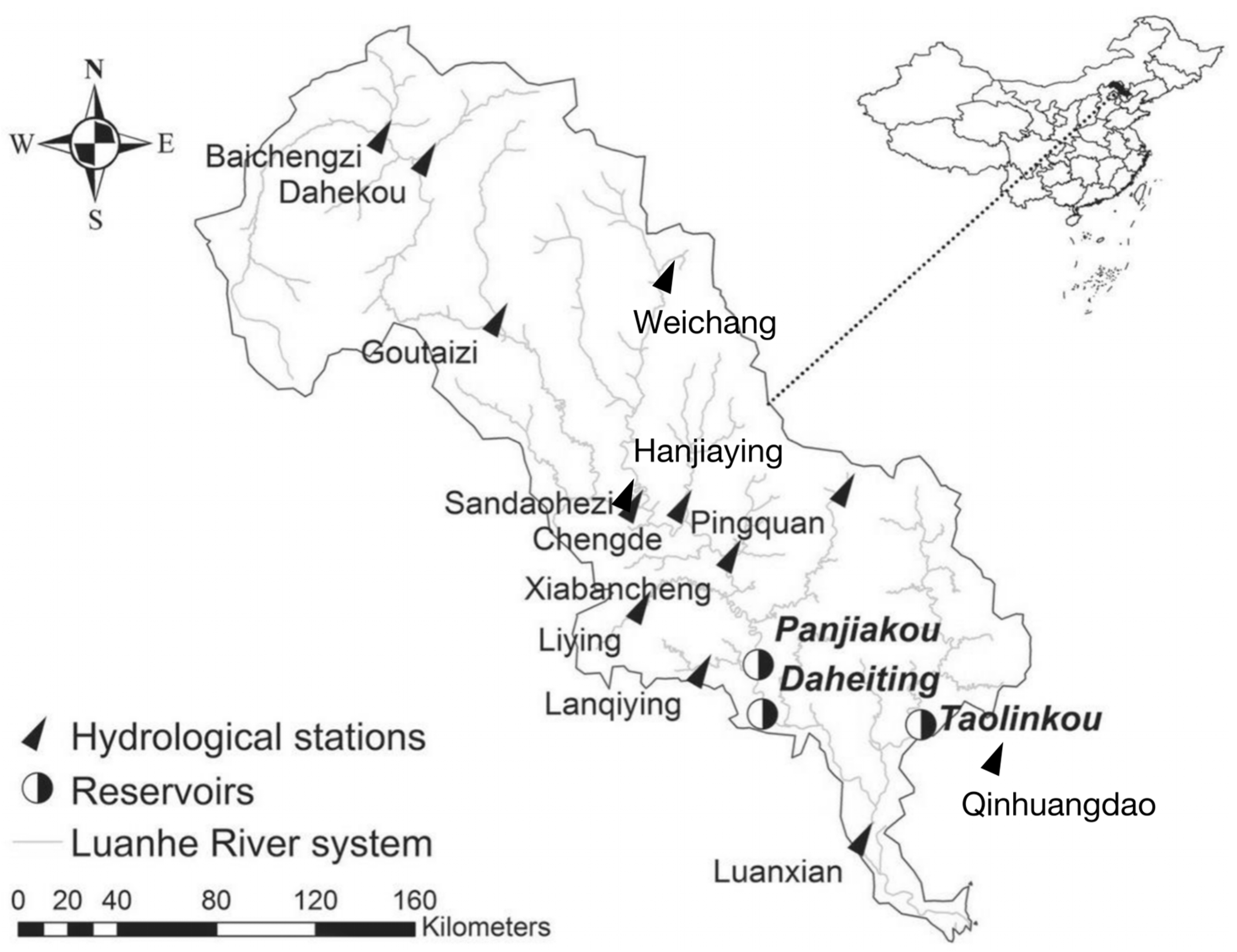
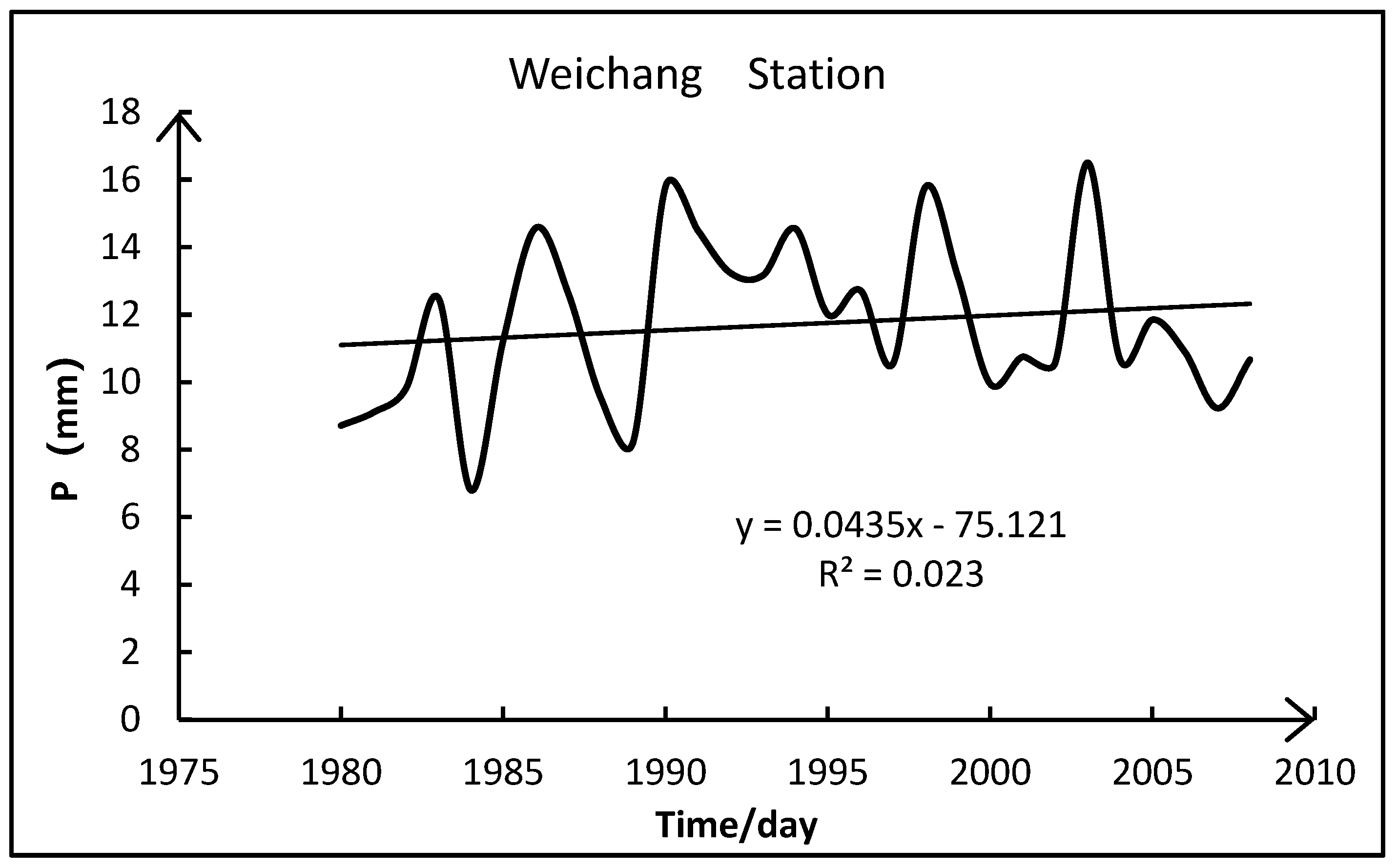
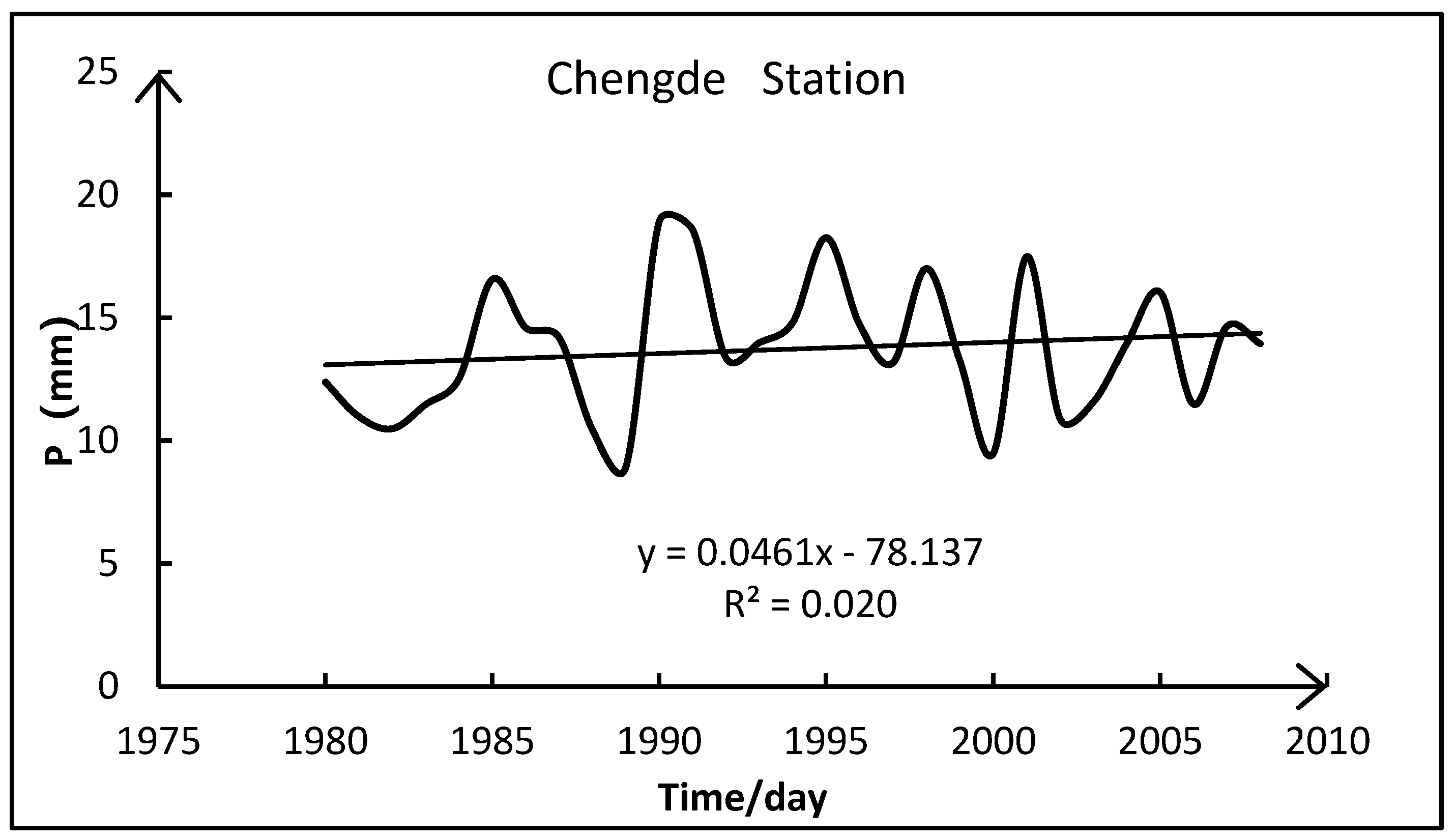
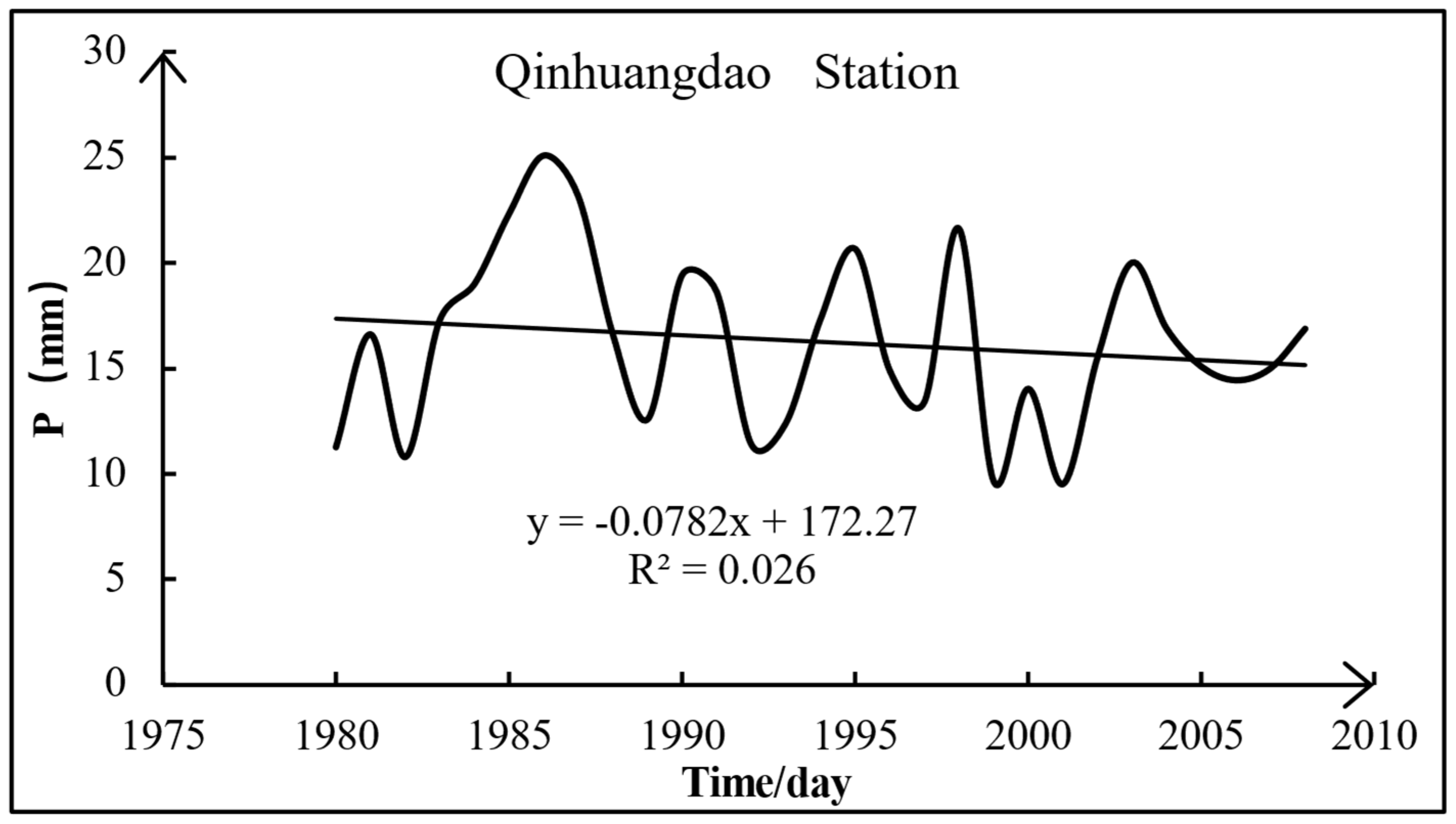
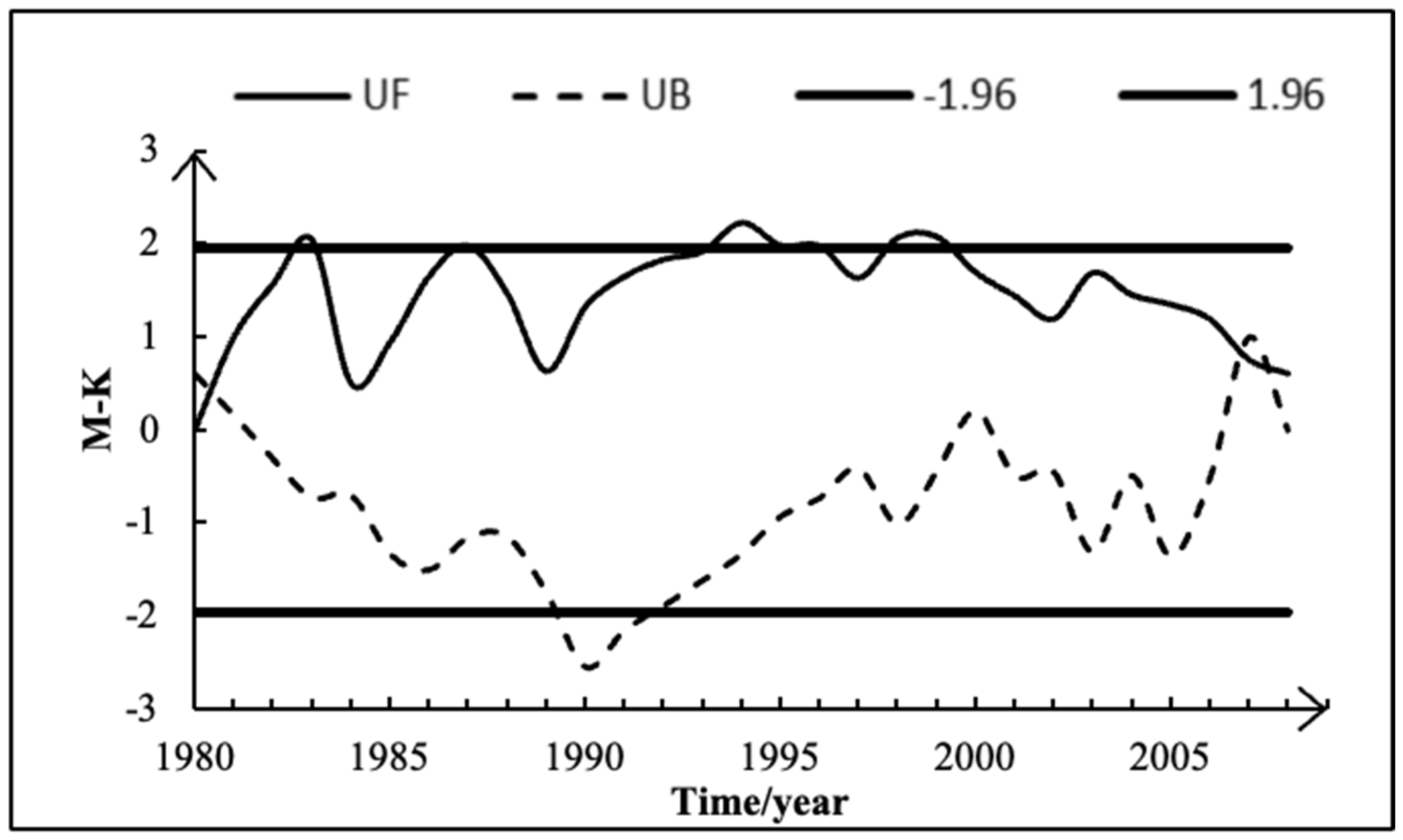
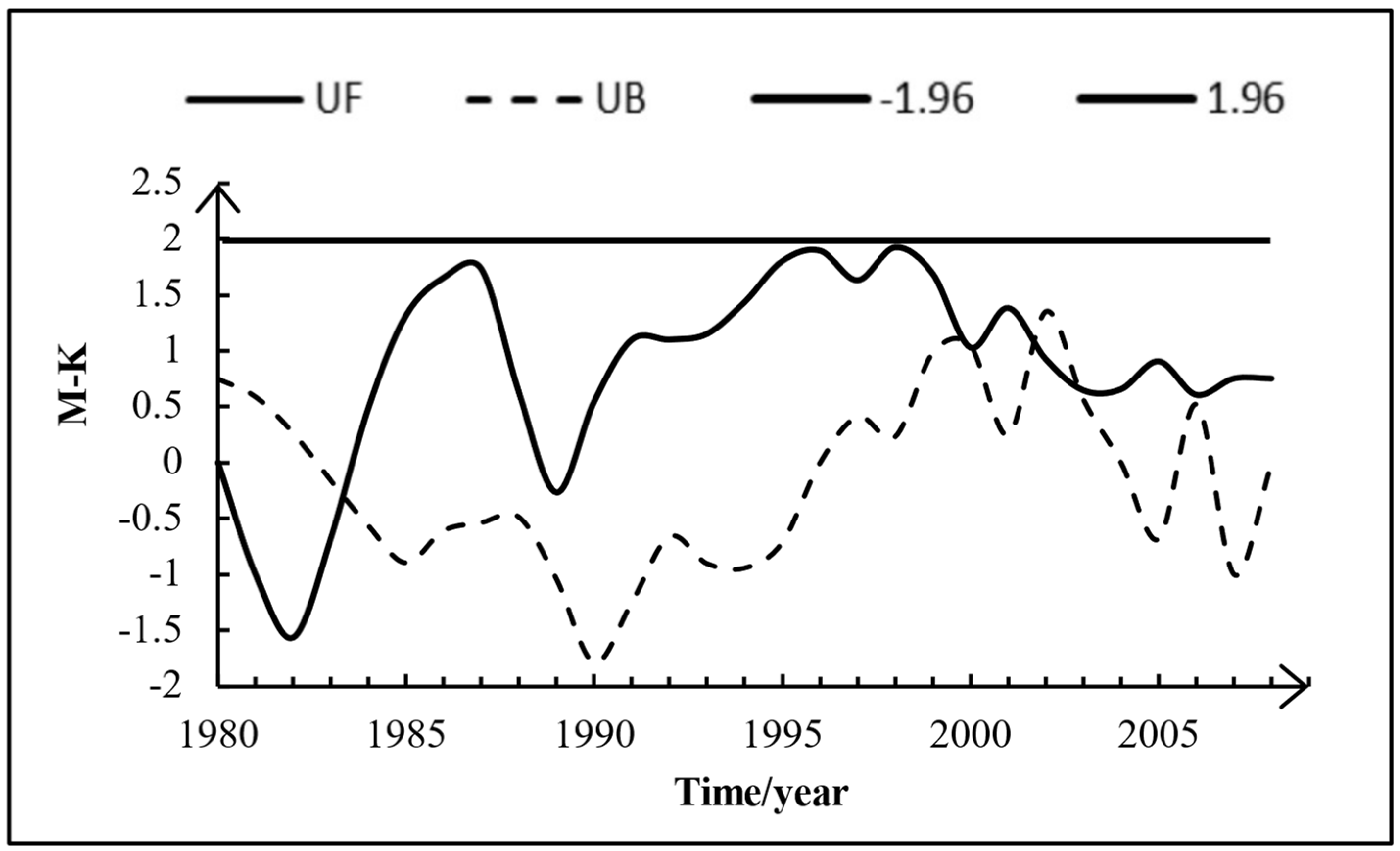
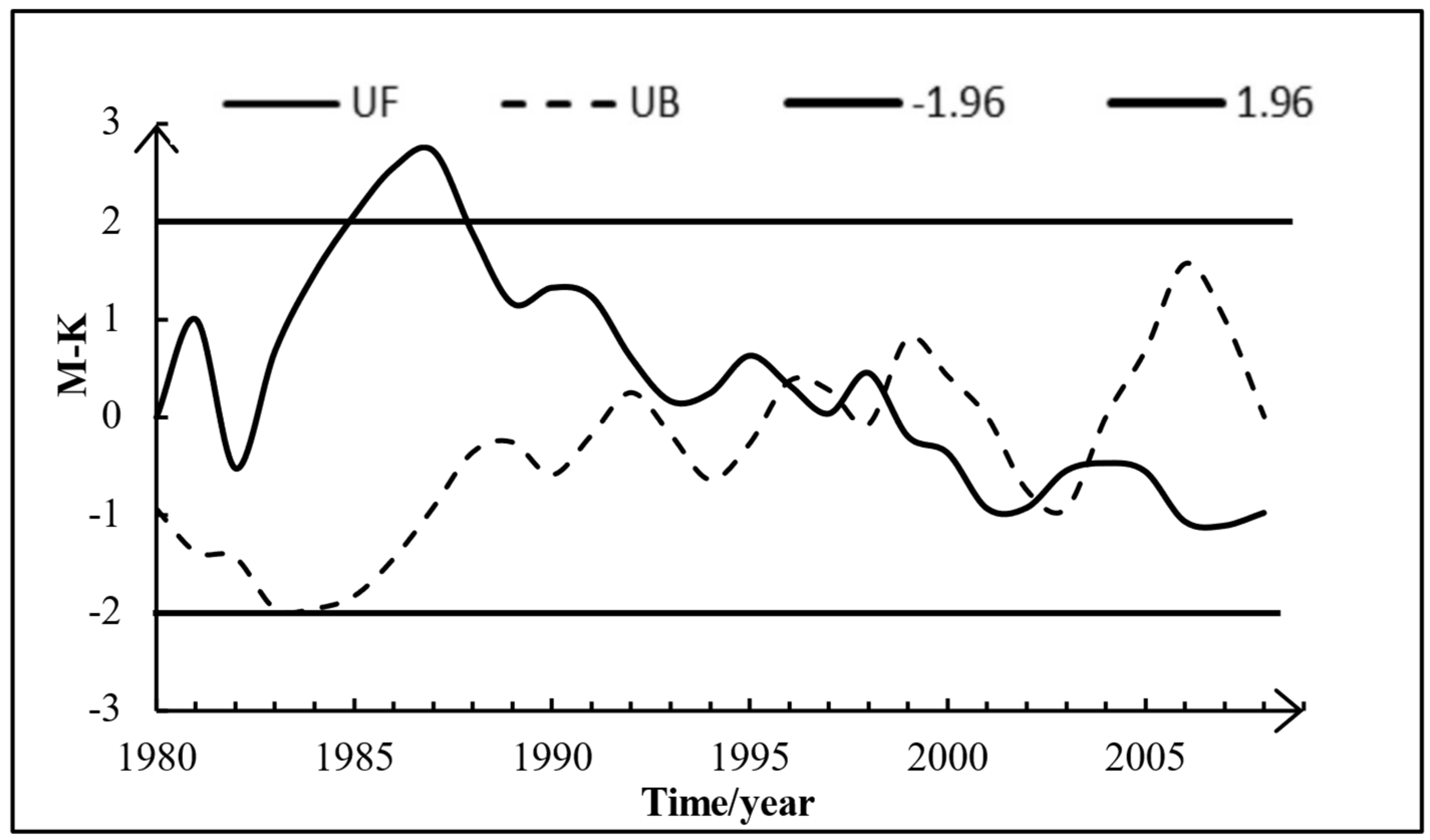


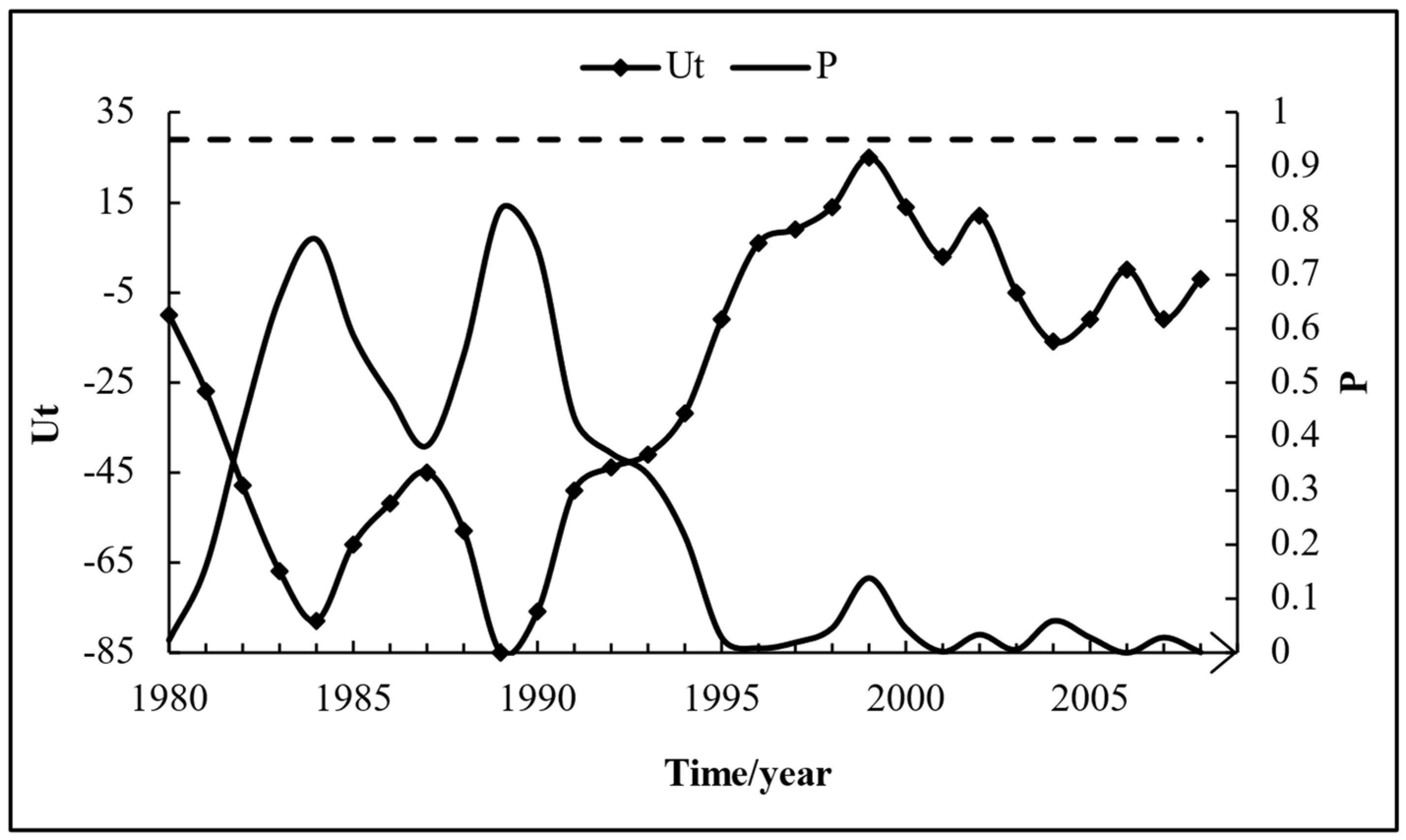
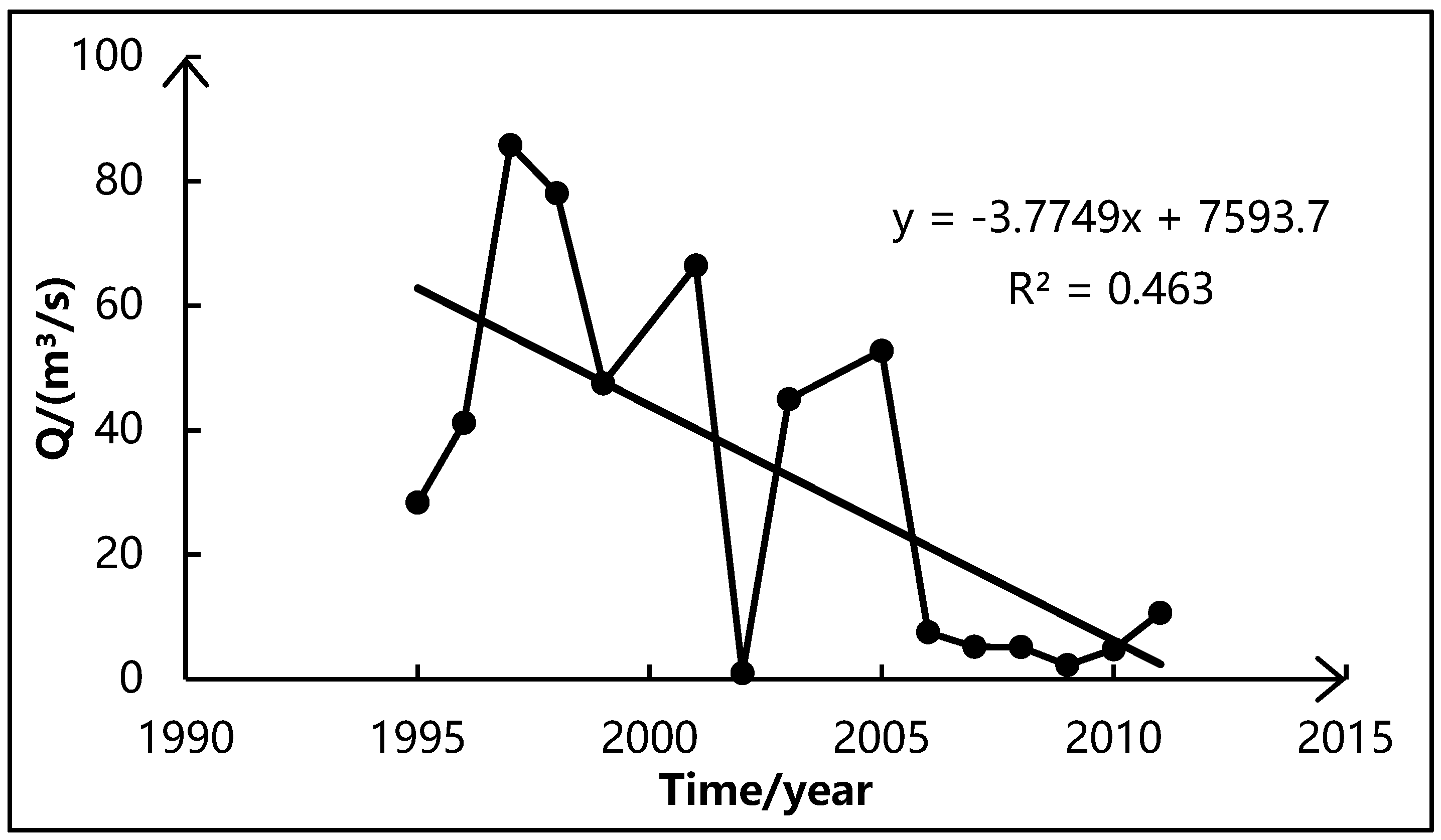

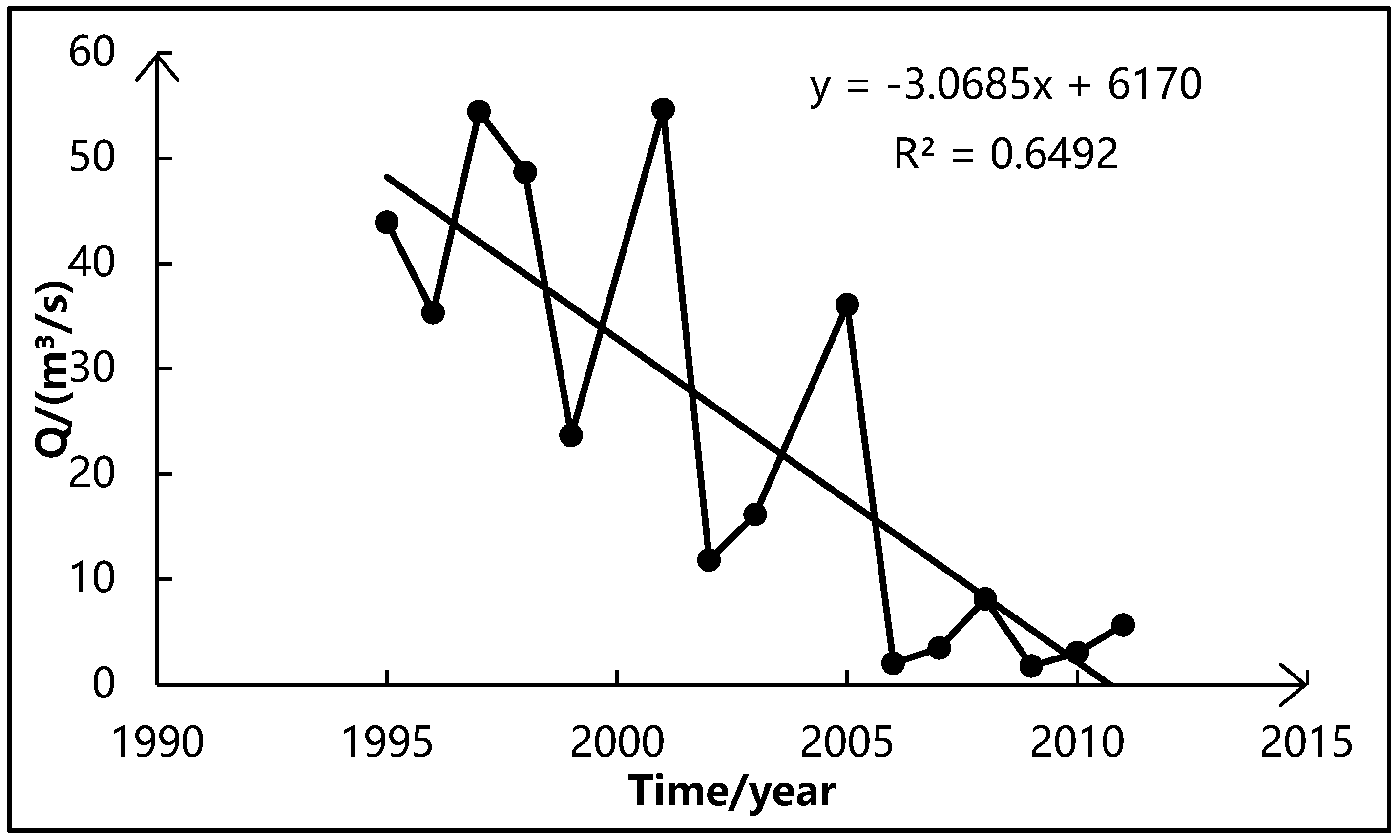
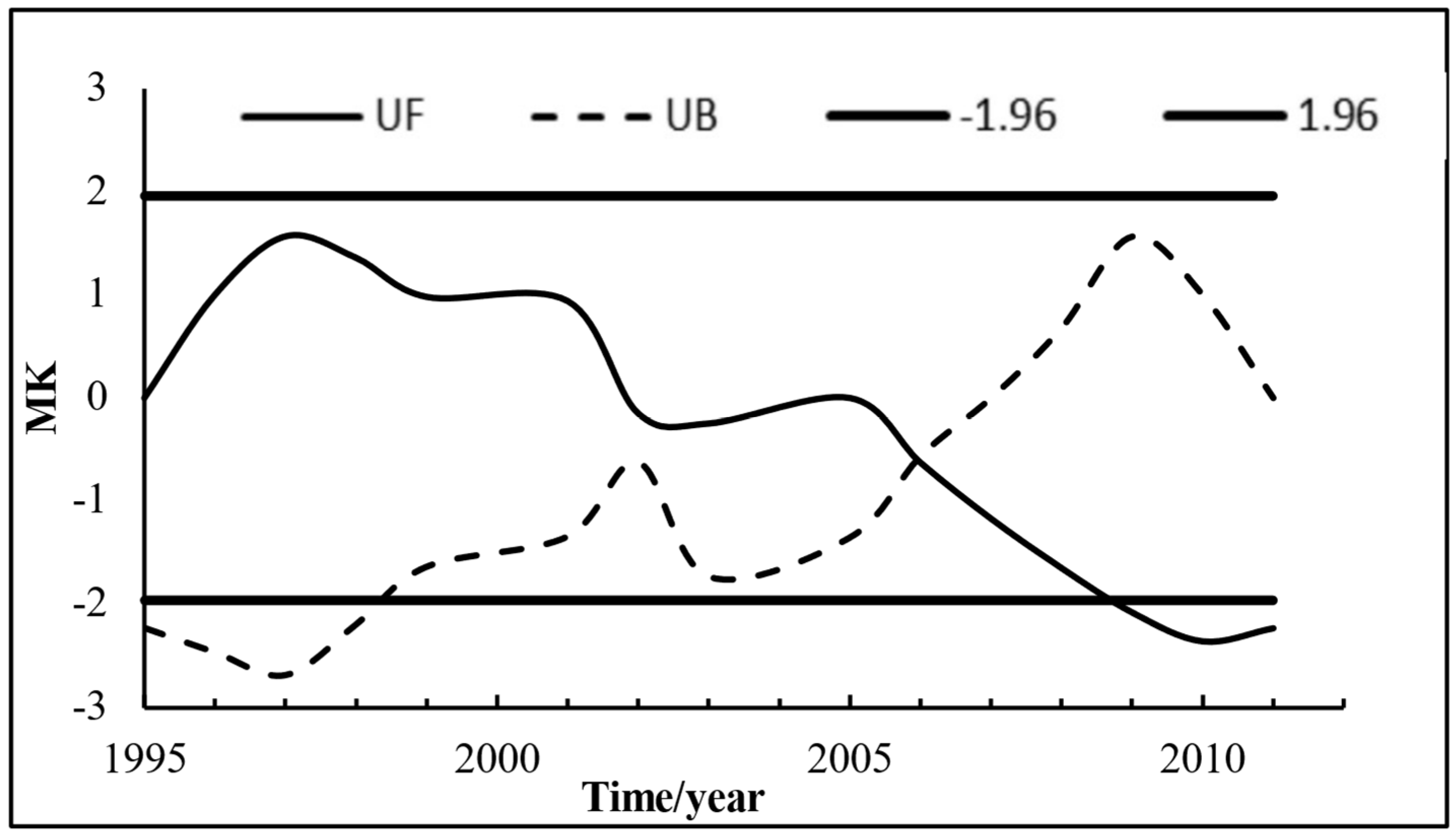
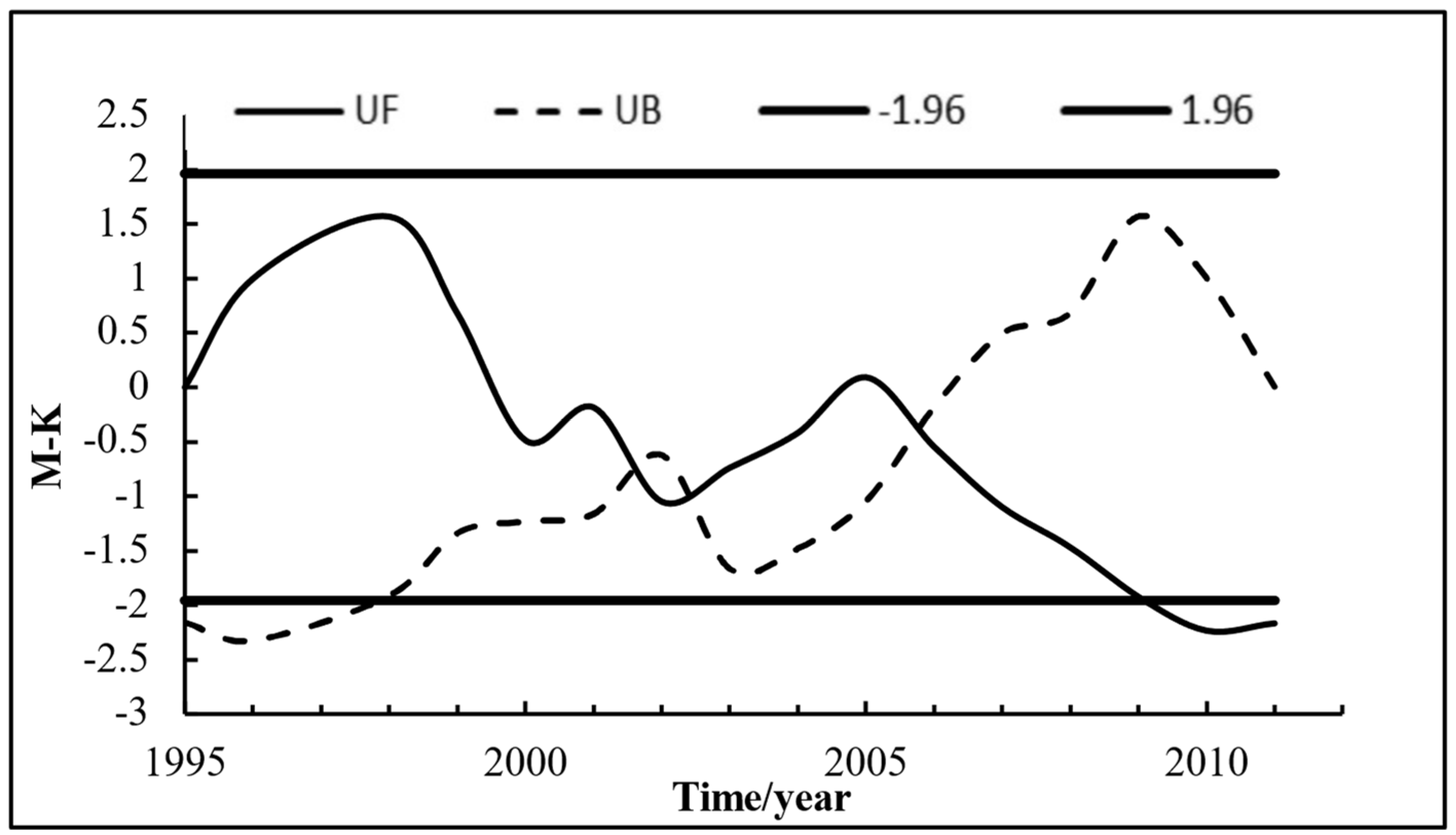

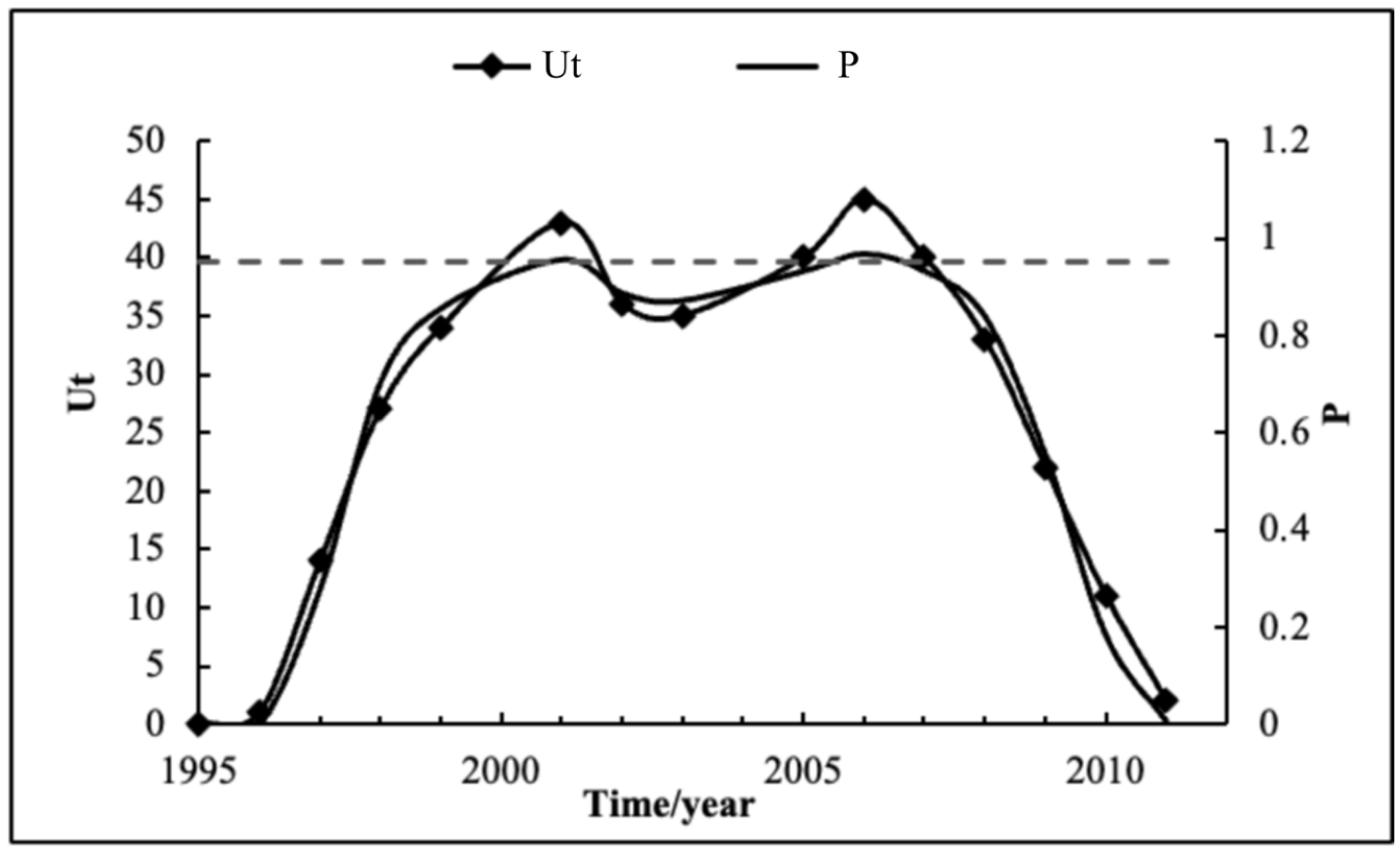


| Station | Statistical Quantity of Test U | Significance Level α | Threshold Uα/2 | Determination Result | Tendency |
|---|---|---|---|---|---|
| Weichang Station | 0.58 | 0.05 | 1.96 | |U| < Uα/2 | Insignificantly increasing |
| Chengde Station | 0.73 | 0.05 | 1.96 | |U| < Uα/2 | Insignificantly increasing |
| Qinhuangdao Station | −0.94 | 0.05 | 1.96 | |U| < Uα/2 | Insignificantly decreasing |
| Station | r | S | Z | Determination Result | Tendency |
|---|---|---|---|---|---|
| Weichang Station | 0.15 | 0.438 | 0.368 | |r| < Z, S > 0.05 | Accept the null hypothesis |
| Chengde Station | −0.174 | 0.367 | 0.368 | |r| < Z, S > 0.05 | Accept the null hypothesis |
| Qinhuangdao Station | −0.138 | 0.0001 | 0.471 | |r| < Z, S > 0.05 | Accept the null hypothesis |
| Method | Weichang Station | Chengde Station | Qinhuangdao Station |
|---|---|---|---|
| Linear trend regression analysis | non-significant increasing | non-significant increasing | non-significant decreasing |
| M-K method | non-significant increasing | non-significant increasing | non-significant decreasing |
| Spearman method | accept the null hypothesis | accept the null hypothesis | accept the null hypothesis |
| Method | Weichang Station | Chengde Station | Qinhuangdao Station |
|---|---|---|---|
| M-K method | 2007 | 2000, 2002, 2003 | 1996, 1997, 1999 |
| MWP method | — | 1999 | — |
| Station | U | α | Uα/2 | Determination Result | Tendency |
|---|---|---|---|---|---|
| Hanjiaying Station | −2.18 | 0.05 | 1.96 | |U| > Uα/2 | Significantly decreasing |
| Sandaohezi Station | −2.12 | 0.05 | 1.96 | |U| > Uα/2 | Significantly decreasing |
| Chengde Station | −2.87 | 0.05 | 1.96 | |U| > Uα/2 | Significantly decreasing |
| Station | r | S | Z | Determination Result | Tendency |
|---|---|---|---|---|---|
| Hanjiaying Station | −0.604 | 0.017 | 0.521 | |r| > Z, S < 0.05 | Significantly decreasing |
| Sandaohezi | −0.6 | 0.014 | 0.503 | |r| > Z, S < 0.05 | Significantly decreasing |
| Chengde Station | −0.789 | 0.0001 | 0.521 | |r| > Z, S < 0.05 | Unusual Significantly decreasing |
| Method | Hanjiaying Station | Sandaohezi Station | Chengde Station |
|---|---|---|---|
| Linear trend regression analysis | Significantly decreasing | Significantly decreasing | Significantly decreasing |
| M-K method | Significantly decreasing | Significantly decreasing | Significantly decreasing |
| Spearman method | Significantly decreasing | Significantly decreasing | Significantly decreasing |
| Method | Hanjiaying Station | Sandaohezi Station | Chengde Station |
|---|---|---|---|
| M-K method | 2006 | 2002, 2003, 2006 | 2002, 2003, 2006 |
| MWP method | 2003, 2006 | 2006 | 2001~2006 |
Disclaimer/Publisher’s Note: The statements, opinions and data contained in all publications are solely those of the individual author(s) and contributor(s) and not of MDPI and/or the editor(s). MDPI and/or the editor(s) disclaim responsibility for any injury to people or property resulting from any ideas, methods, instructions or products referred to in the content. |
© 2024 by the authors. Licensee MDPI, Basel, Switzerland. This article is an open access article distributed under the terms and conditions of the Creative Commons Attribution (CC BY) license (https://creativecommons.org/licenses/by/4.0/).
Share and Cite
Shan, C.; Zhao, F.; Wang, Y.; Yang, C.; Wei, F.; Zhou, X. Study on the Evolvement Trend Process of Hydrological Elements in Luanhe River Basin, China. Water 2024, 16, 1169. https://doi.org/10.3390/w16081169
Shan C, Zhao F, Wang Y, Yang C, Wei F, Zhou X. Study on the Evolvement Trend Process of Hydrological Elements in Luanhe River Basin, China. Water. 2024; 16(8):1169. https://doi.org/10.3390/w16081169
Chicago/Turabian StyleShan, Chengju, Fuwei Zhao, Yuejing Wang, Chenggang Yang, Fusen Wei, and Xueyang Zhou. 2024. "Study on the Evolvement Trend Process of Hydrological Elements in Luanhe River Basin, China" Water 16, no. 8: 1169. https://doi.org/10.3390/w16081169




